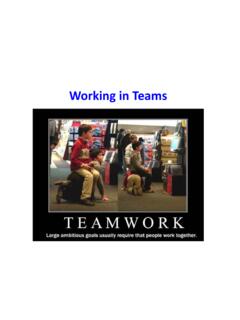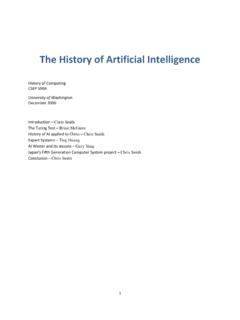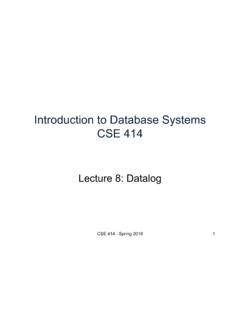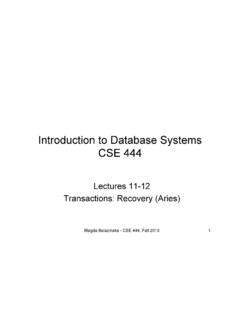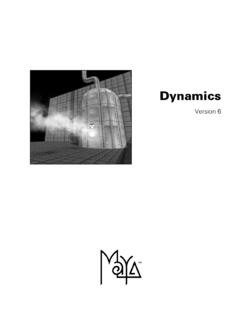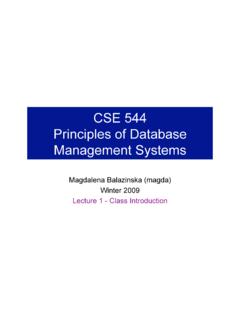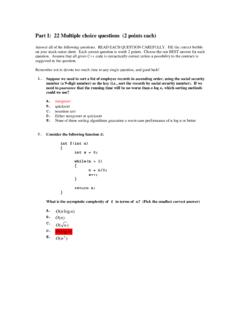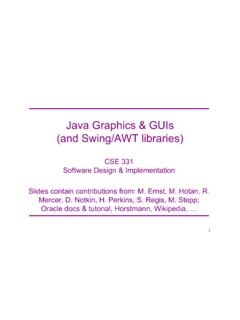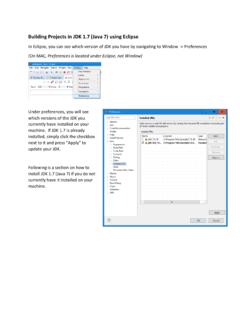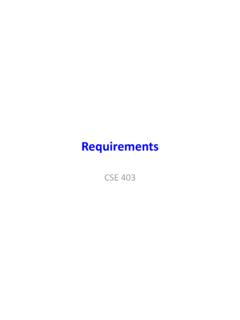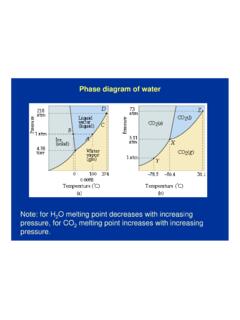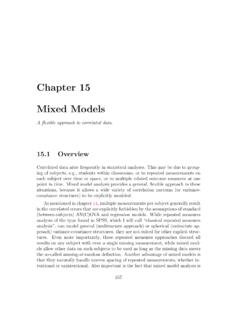Transcription of A pipeline diagram - University of Washington
1 A pipeline diagram Clock cycle 1 2 3 4 5 6 7 8 9. lw $t0, 4($sp) IF ID EX MEM WB. sub $v0, $a0, $a1 IF ID EX MEM WB. and $t1, $t2, $t3 IF ID EX MEM WB. or $s0, $s1, $s2 IF ID EX MEM WB. add $sp, $sp, -4 IF ID EX MEM WB. A pipeline diagram shows the execution of a series of instructions. The instruction sequence is shown vertically, from top to bottom. Clock cycles are shown horizontally, from left to right. Each instruction is divided into its component stages. (We show five stages for every instruction, which will make the control unit easier.). This clearly indicates the overlapping of instructions. For example, there are three instructions active in the third cycle above. The lw instruction is in its Execute stage. Simultaneously, the sub is in its Instruction Decode stage. Also, the and instruction is just being fetched. 1. pipeline terminology Clock cycle 1 2 3 4 5 6 7 8 9. lw $t0, 4($sp) IF ID EX MEM WB. sub $v0, $a0, $a1 IF ID EX MEM WB. and $t1, $t2, $t3 IF ID EX MEM WB. or $s0, $s1, $s2 IF ID EX MEM WB.
2 Add $sp, $sp, -4 IF ID EX MEM WB. filling full emptying The pipeline depth is the number of stages in this case, five. In the first four cycles here, the pipeline is filling, since there are unused functional units. In cycle 5, the pipeline is full. Five instructions are being executed simultaneously, so all hardware units are in use. In cycles 6-9, the pipeline is emptying. 2. Pipelined datapath and control Now we'll see a basic implementation of a pipelined processor. The datapath and control unit share similarities with both the single- cycle and multicycle implementations that we already saw. An example execution highlights important pipelining concepts. In future lectures, we'll discuss several complications of pipelining that we're hiding from you for now. 3. Pipelining concepts A pipelined processor allows multiple instructions to execute at once, and each instruction uses a different functional unit in the datapath. This increases throughput, so programs can run faster. One instruction can finish executing on every clock cycle, and simpler stages also lead to shorter cycle times.
3 Clock cycle 1 2 3 4 5 6 7 8 9. lw $t0, 4($sp) IF ID EX MEM WB. sub $v0, $a0, $a1 IF ID EX MEM WB. and $t1, $t2, $t3 IF ID EX MEM WB. or $s0, $s1, $s2 IF ID EX MEM WB. add $t5, $t6, $0 IF ID EX MEM WB. 4. Pipelined Datapath The whole point of pipelining is to allow multiple instructions to execute at the same time. We may need to perform several operations in the same cycle. Increment the PC and add registers at the same time. Fetch one instruction while another one reads or writes data. Clock cycle 1 2 3 4 5 6 7 8 9. lw $t0, 4($sp) IF ID EX MEM WB. sub $v0, $a0, $a1 IF ID EX MEM WB. and $t1, $t2, $t3 IF ID EX MEM WB. or $s0, $s1, $s2 IF ID EX MEM WB. add $t5, $t6, $0 IF ID EX MEM WB. Thus, like the single-cycle datapath, a pipelined processor will need to duplicate hardware elements that are needed several times in the same clock cycle. 5. One register file is enough We need only one register file to support both the ID and WB stages. Read Read register 1 data 1. Read Read register 2 data 2.
4 Write register Registers Write data Reads and writes go to separate ports on the register file. Writes occur in the first half of the cycle, reads occur in the second half. 6. Single-cycle datapath, slightly rearranged 1. 0. PCSrc 4. Add P Add C Shift RegWrite left 2. Read Read register 1 data 1 MemWrite ALU. Read Instruction Zero Read Read address [31-0] 0. register 2 data 2 Result Address Write 1 Data Instruction register MemToReg memory memory Registers ALUOp Write data ALUSrc Write Read 1. data data Instr [15 - 0] Sign RegDst extend MemRead 0. Instr [20 - 16]. 0. Instr [15 - 11]. 1. 7. What's been changed? Almost nothing! This is equivalent to the original single-cycle datapath. There are separate memories for instructions and data. There are two adders for PC-based computations and one ALU. The control signals are the same. Only some cosmetic changes were made to make the diagram smaller. A few labels are missing, and the muxes are smaller. The data memory has only one Address input.
5 The actual memory operation can be determined from the MemRead and MemWrite control signals. The datapath components have also been moved around in preparation for adding pipeline registers. 8. Multiple cycles In pipelining, we also divide instruction execution into multiple cycles. Information computed during one cycle may be needed in a later cycle. The instruction read in the IF stage determines which registers are fetched in the ID stage, what constant is used for the EX stage, and what the destination register is for WB. The registers read in ID are used in the EX and/or MEM stages. The ALU output produced in the EX stage is an effective address for the MEM stage or a result for the WB stage. We added several intermediate registers to the multicycle datapath to preserve information between stages, as highlighted on the next slide. 9. Registers added to the multi-cycle PCWrite PC ALUSrcA. IorD. 0. RegDst RegWrite M. MemRead u 0 0. Read Read x M A ALU M. u Address register 1 data 1 1 u Zero x ALU x IRWrite Read Result 1 Memory register 2 Read B Out 1.
6 0 0. data 2. [31-26] M Write 4 1 PCSource Write Mem u register [25-21] 2 ALUOp data Data x [20-16] Write 1 Registers 3. [15-11] data MemWrite [15-0]. Instruction 0 ALUSrcB. register M. u Sign Shift Memory x extend left 2. data 1. register MemToReg 10. pipeline registers We'll add intermediate registers to our pipelined datapath too. There's a lot of information to save, however. We'll simplify our diagrams by drawing just one big pipeline register between each stage. The registers are named for the stages they connect. IF/ID ID/EX EX/MEM MEM/WB. No register is needed after the WB stage, because after WB the instruction is done. 11. Pipelined datapath 1. 0. PCSrc IF/ID ID/EX EX/MEM MEM/WB. 4. Add P Add C Shift RegWrite left 2. Read Read register 1 data 1 MemWrite ALU. Read Instruction Zero Read Read address [31-0] 0. register 2 data 2 Result Address Write 1 Data Instruction register MemToReg memory memory Registers ALUOp Write data ALUSrc Write Read 1. data data Instr [15 - 0] Sign RegDst extend MemRead 0.
7 Instr [20 - 16]. 0. Instr [15 - 11]. 1. 12. Propagating values forward Any data values required in later stages must be propagated through the pipeline registers. The most extreme example is the destination register. The rd field of the instruction word, retrieved in the first stage (IF), determines the destination register. But that register isn't updated until the fifth stage (WB). Thus, the rd field must be passed through all of the pipeline stages, as shown in red on the next slide. Why can't we keep a single instruction register like we did in the multi- cycle data-path? 13. The destination register 1. 0. PCSrc IF/ID ID/EX EX/MEM MEM/WB. 4. Add P Add C Shift RegWrite left 2. Read Read register 1 data 1 MemWrite ALU. Read Instruction Zero Read Read address [31-0] 0. register 2 data 2 Result Address Write 1 Data Instruction register MemToReg memory memory Registers ALUOp Write data ALUSrc Write Read 1. data data Instr [15 - 0] Sign RegDst extend MemRead 0. Instr [20 - 16]. 0. Instr [15 - 11].
8 1. 14. What about control signals? The control signals are generated in the same way as in the single-cycle processor after an instruction is fetched, the processor decodes it and produces the appropriate control values. But just like before, some of the control signals will not be needed until some later stage and clock cycle. These signals must be propagated through the pipeline until they reach the appropriate stage. We can just pass them in the pipeline registers, along with the other data. Control signals can be categorized by the pipeline stage that uses them. 15. Pipelined datapath and control 1. 0. ID/EX. WB EX/MEM. PCSrc Control M WB MEM/WB. IF/ID EX M WB. 4. Add P Add C Shift RegWrite left 2. Read Read register 1 data 1 MemWrite ALU. Read Instruction Zero Read Read address [31-0] 0. register 2 data 2 Result Address Write 1 Data Instruction register MemToReg memory memory Registers ALUOp Write data ALUSrc Write Read 1. data data Instr [15 - 0] Sign RegDst extend MemRead 0. Instr [20 - 16].
9 0. Instr [15 - 11]. 1. 16. What about control signals? The control signals are generated in the same way as in the single-cycle processor after an instruction is fetched, the processor decodes it and produces the appropriate control values. But just like before, some of the control signals will not be needed until some later stage and clock cycle. These signals must be propagated through the pipeline until they reach the appropriate stage. We can just pass them in the pipeline registers, along with the other data. Control signals can be categorized by the pipeline stage that uses them. Stage Control signals needed EX ALUSrc ALUOp RegDst MEM MemRead MemWrite PCSrc WB RegWrite MemToReg 17. Pipelined datapath and control 1. 0. ID/EX. WB EX/MEM. PCSrc Control M WB MEM/WB. IF/ID EX M WB. 4. Add P Add C Shift RegWrite left 2. Read Read register 1 data 1 MemWrite ALU. Read Instruction Zero Read Read address [31-0] 0. register 2 data 2 Result Address Write 1 Data Instruction register MemToReg memory memory Registers ALUOp Write data ALUSrc Write Read 1.
10 Data data Instr [15 - 0] Sign RegDst extend MemRead 0. Instr [20 - 16]. 0. Instr [15 - 11]. 1. 18. Notes about the diagram The control signals are grouped together in the pipeline registers, just to make the diagram a little clearer. Not all of the registers have a write enable signal. Because the datapath fetches one instruction per cycle, the PC must also be updated on each clock cycle. Including a write enable for the PC would be redundant. Similarly, the pipeline registers are also written on every cycle, so no explicit write signals are needed. 19. An example execution sequence Here's a sample sequence of instructions to execute. addresses 1000: lw $8, 4($29). 1004: sub $2, $4, $5. in decimal 1008: and $9, $10, $11. 1012: or $16, $17, $18. 1016: add $13, $14, $0. We'll make some assumptions, just so we can show actual data values. Each register contains its number plus 100. For instance, register $8. contains 108, register $29 contains 129, and so forth. Every data memory location contains 99.
